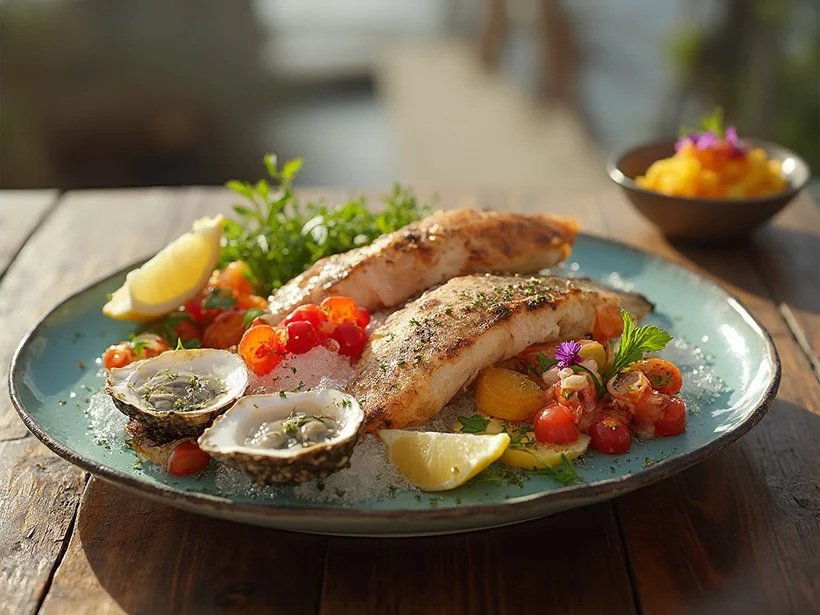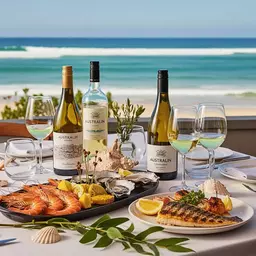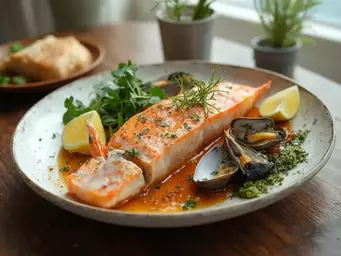Sustainable Seafood Trends in Australia

As more diners prioritize sustainability, it is essential to understand the impact of our seafood choices. How can you ensure that your next meal contributes to healthier oceans while delighting your palate?
What You Will Learn
- Sustainable seafood practices focus on maintaining healthy fish populations and protecting marine ecosystems.
- The Marine Stewardship Council (MSC) provides a trusted certification for sustainable fishing that consumers can rely on.
- Australian restaurants are increasingly adopting sustainable seafood sourcing due to consumer demand and environmental awareness.
- Trends in dining include a shift towards hyper-local seafood, seasonal menus, and transparency about sourcing practices.
Sustainable Seafood Insights
Key drivers and practices shaping the sustainable seafood landscape in Australian dining.
Drivers of Sustainable Seafood Adoption
- • Consumer Demand
- • Environmental Awareness
- • Regulatory Changes
Key Principles of Sustainable Harvesting
- • Responsible Fishing Methods
- • Fish Population Management
- • Community Involvement
MSC Certification Benefits
- • Well-managed Fisheries
- • Responsible Practices
- • Informed Consumer Choices
Trends in Sustainable Seafood Menus
- • Hyper-Local Sourcing
- • Seasonal Offerings
- • Creative Dishes
The Growing Importance of Sustainable Seafood in Australian Dining
As a passionate food enthusiast, I believe that understanding the role of sustainable seafood in our dining experiences is essential. Sustainability isn’t just a trend; it’s a commitment to preserving the ocean’s resources while enjoying the diverse flavors it offers. The growing movement towards sustainable seafood reflects a deep respect for our marine ecosystems and the communities that rely on them.
In recent years, diners are becoming more aware and concerned about where their food comes from. With Australia being surrounded by vast oceans, we have a wealth of seafood at our fingertips, and with that comes the responsibility to ensure that we’re sourcing it sustainably. It’s not just about enjoying a delicious meal but supporting practices that protect our environment and promote long-term viability. Furthermore, the Australian government is urged to tighten seafood import rules, highlighting the importance of responsible sourcing both domestically and internationally.
Understanding Sustainable Seafood: Definitions and Principles
Sustainable seafood can be broadly defined as seafood that is harvested in a way that maintains the health of fish populations and the well-being of the marine environment. This includes practices that prevent overfishing, minimize habitat destruction, and reduce bycatch. Here are some key principles:
- Responsible fishing methods: Using techniques that do not harm ocean habitats.
- Fish population management: Ensuring fish stocks remain healthy and sustainable.
- Community involvement: Supporting local fisheries and economies.
These principles guide both consumers and restaurants in making choices that reflect a commitment to the environment. At The Yellow Tail Table, we aim to spotlight these principles while sharing delicious recipes and insights that celebrate Australian cuisine. The National Fisheries Plan also outlines strategies for effective management of Australian fisheries, contributing to these sustainable practices.
The Role of the Marine Stewardship Council (MSC) in Promoting Sustainable Practices
The Marine Stewardship Council (MSC) plays a pivotal role in the sustainable seafood movement. Founded in 1997, the MSC sets standards for sustainable fishing and seafood tracing, providing a certification mark that consumers can trust. This certification helps to:
- Ensure seafood is sourced from well-managed fisheries.
- Promote responsible fishing practices among suppliers.
- Inspire chefs and restaurants to adopt sustainable sourcing strategies.
As we look to the future, the MSC certification can guide diners in making informed choices about their seafood consumption, and it encourages restaurants to participate in sustainable practices. It’s a powerful way of connecting the dots between what’s on our plates and the health of our oceans.
Why Australian Restaurants Are Embracing Sustainability
More and more, Australian restaurants are embracing sustainability—not just as a marketing tactic but as a core value. The push for sustainable seafood is influenced by several factors:
- Consumer demand: Diners increasingly prefer restaurants that prioritize sustainability.
- Environmental awareness: Chefs and owners recognize the impact of their sourcing choices on the environment.
- Regulatory changes: New policies encourage restaurants to adopt sustainable practices.
At The Yellow Tail Table, I’ve witnessed firsthand how restaurants committed to sustainability not only create a positive impact on the environment but also enhance their dining experiences. Sustainable seafood is not merely an option; it’s becoming a vital component of modern Australian dining culture! By supporting local fisheries and ethical practices, we help ensure that our culinary landscape remains vibrant for generations to come. The AFMA Annual Report provides further details on Australia's efforts to manage fisheries sustainably.
Pro Tip
When dining out, don't hesitate to ask your server about the seafood's origin! Engaging in conversation about the sourcing practices not only helps you make informed choices but also encourages restaurants to prioritize sustainable options.
Current Trends Shaping the Sustainable Seafood Landscape
The culinary world is evolving, and one of the most exciting trends shaping modern Australian dining is the commitment to sustainable seafood. As diners become increasingly aware of their food choices, restaurants are responding with exciting, eco-friendly practices that not only celebrate our ocean's bounty but also protect it. I’ve seen firsthand how this shift is not just beneficial for our environment but also enhances the dining experience!
At The Yellow Tail Table, we embrace this shift wholeheartedly, recognizing the importance of ethical sourcing and supporting local communities. By highlighting these practices, we can foster a deeper connection between diners and the food they enjoy. Let's explore the key trends in sustainable seafood that are shaping our dining landscape.
Consumer Demand for Ethical Sourcing and Eco-Friendly Practices
More than ever, consumers are prioritizing sustainability in their dining choices. They want to know where their seafood comes from and how it was caught. This increased awareness is leading to a demand for restaurants that practice ethical sourcing and provide transparency regarding their ingredients. It's inspiring to witness how diners are willing to support establishments that share their values!
- Transparency: Diners seek restaurants that openly share information about their seafood sources.
- Quality over Quantity: There is a growing preference for quality seafood from sustainable sources over mass-produced options.
- Community Engagement: Consumers are more likely to support restaurants that engage with local fisheries and promote their sustainability efforts.
By listening to these preferences, restaurants can thrive in a competitive market while also supporting the health of our oceans. It's a win-win for both business and the environment!
Hyper-Local Seafood: Supporting Local Fisheries and Communities
Another trend gaining traction is the focus on hyper-local seafood. By sourcing seafood from nearby fisheries, restaurants not only reduce their carbon footprint but also bolster local economies. This practice fosters relationships between chefs and fishers, creating a community that values sustainable practices.
- Seasonal Offerings: Menus that adapt to seasonal catches promote freshness and flavor.
- Community Partnerships: Collaborating with local fishers ensures a reliable supply of sustainable seafood.
- Education and Awareness: Chefs can educate diners on the benefits of supporting local seafood sources.
At The Yellow Tail Table, we love highlighting local seafood offerings in our recipes, showcasing the incredible flavors and stories behind each catch. It’s about creating a shared culinary journey that connects diners to the land and sea!
Seafood Menu Trends: Incorporating Seasonal and Local Ingredients
As we continue to embrace sustainability, more restaurants are integrating seasonal and local ingredients into their seafood menus. This trend not only supports local agriculture but also enhances the dining experience by offering fresh, vibrant flavors that resonate with Australian cuisine.
- Diverse Flavors: Seasonal menus allow for exciting variations in flavor profiles.
- Creative Dishes: Chefs are inspired to create innovative dishes that reflect the best of what’s available locally.
- Healthier Choices: Fresh ingredients often lead to healthier meal options for diners.
By focusing on seasonal and local ingredients, we can create dishes that tell a story and celebrate the richness of Australia’s food culture. Every meal becomes an adventure that supports both our health and our planet!
Frequently Asked Questions About Sustainable Seafood
- What is sustainable seafood?
- Sustainable seafood is harvested in a way that ensures the long-term health of fish populations and marine ecosystems, minimizing environmental impact such as overfishing, habitat destruction, and bycatch.
- How does the Marine Stewardship Council (MSC) help promote sustainable seafood?
- The MSC sets global standards for sustainable fishing and provides a certification label for seafood sourced from well-managed fisheries. This helps consumers make informed choices and encourages retailers and restaurants to adopt sustainable sourcing practices.
- Why are Australian restaurants adopting sustainable seafood practices?
- Australian restaurants are embracing sustainability due to increasing consumer demand for ethically sourced food, growing environmental awareness among chefs and owners, and evolving regulatory changes that encourage responsible practices.
- What are some current trends in sustainable seafood dining?
- Current trends include a strong consumer demand for transparency and ethical sourcing, a focus on "hyper-local" seafood to support local fisheries and reduce carbon footprints, and the incorporation of seasonal and local ingredients into menus for fresher, more diverse culinary offerings.
- How can I, as a diner, support sustainable seafood practices?
- You can support sustainable seafood by looking for MSC-certified products, asking restaurants about their seafood sourcing, choosing seasonal and local options, and prioritizing establishments that demonstrate transparency and commitment to ethical practices.
Recap of Key Points
Here is a quick recap of the important points discussed in the article:
- Sustainable seafood is vital for preserving marine ecosystems and supporting local communities.
- Key principles include responsible fishing methods, fish population management, and community involvement.
- The Marine Stewardship Council (MSC) provides certification for sustainable fishing, ensuring responsible sourcing.
- Consumer demand for ethical sourcing is driving restaurants to prioritize sustainability in their seafood offerings.
- Hyper-local seafood supports local fisheries and reduces carbon footprints through community partnerships.
- Incorporating seasonal and local ingredients enhances dining experiences and promotes healthier choices.








